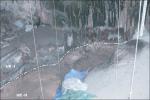Summary (English)
The cavity is a complex development with several openings on the right-hand side of the Famorca ravine, which, further down, make up the route of the River Gorgos in its journey to the bay of Jávea. The site is located some 50 kilometres from the current coast and at an altitude of over 600 meters. Its deposit contains stratified settlements from the Neolithic II (horizon of combed and sgraffito pottery), from the Geometric Mesolithic and the notched and denticulated from the sauveterroide and microlaminar Epipaleolithic, from the Upper Magdalenian and from the entire Solutrean.
The remains identified, without stratigraphic linkage, allow us to recognize human presence, at more or less isolated instances for the Chalcolithic, Iberian Age, Late Roman Age, Al-Andalus periods…, until the last shepherds of the 20th century.
- West Mouth: one of the defined goals of this season was to complete the topography of the speleothem on which the archaeological deposits from this mouth sit. To this end, layers 14 to 23 were excavated, allowing the establishment of an more appropriate interpretation of the occupancies dated from 11,500 to 9,000 BP. This documentation is consistent with the strong dip of the SM-3 unit, placed upon a level of collapse blocks.
The materials recovered do not record a significant transformation of the morphotypology of the lithic complex, characterised by the overwhelming presence of the scrapers and microlaminar tooling. The bone industry is limited to fragments of moulds, some thin tip and other pointed bone items.
As for the ornaments, the selection of the most common marine and freshwater gastropods are repeated: Cyclope sp. and Theodoxus fluviatilis. The paleobiologic remains continue to abound and represent outstanding preservation. To carbon dust residues and some fruits identified during the excavation process are added some fragments of thermoaltered soil with stamps and a remarkable amount of fauna remains: Capra pyrenaica, Cervus elaphus, Sus scropha, Rupicapra rupicapra, Lynx pardina and Vulpes vulpes, in addition to the common Oryctolagus cuniculus. As in other seasons, scant remains of bird fauna, icthyofauna and marine malacofauna have been recovered. In conclusion, the excavation of this hall has allowed a deeper understanding of the paleotopography of the site and its impact on the arrangement and current preservation of the deposits.
- East Mouth or Corral del Gordo: for a second successive year we have returned to work in this mouth excavating the levels of the Late Pleistocene. It is a succession of encased basins containing Magdalenian and Solutrean materials. It is a depot with fewer traces of anthropic presence compared to that recorded in the West Mouth; there is a smaller number of paleobiologic remains and there are a few stone tools (scrapers and some fragments of Solutrean foliaceus). The discovery of a set of ornamental pieces stand out (scaphopodus, bivalves and mariner gastropods). Capra pyrenaica, Cervus elaphus, Equus caballus, Bos primigenius, Lynx pardina and Oryctolagus cuniculus have been identified among the fauna. Furthermore, two accumulations of compact ashes that seem to sit on the basal speleothem have been excavated and samples taken.
One of the findings to note in the current season has been the recovery of several human remains, both from the cranial and post-cranial skeleton. Its appearance adds complexity to a space of which the configuration and borders must have undergone significant historic changes on the basis of the numerous fragments of speleothem used by the shepherds to erect dry stone walls that enclose it. The only two Radiocarbon dates availables for this unit are 11,020 + 140 BP (Beta 75225) and 14,310 + 190 BP (Beta 75226), both obtained through conventional procedure on the basis of charcoal.
(translation by Esther Casares Carmona)
- Joan Emili Aura Tortosa, Juan Vicente Morales Pérez y Carles Miret i Estruch
Director
- Joan Emili Aura Tortosa
Team
- Museo Arqueológico Municipal “Camil Visedo Moltó”
Research Body
- Colegio Oficial de Doctores y Licenciados en Filosofía y Letras y en Ciencias de Alicante - Sección de Arqueología
- Universidad de Valencia
Funding Body
- Universidad de Valencia – Generalitat Valenciana






![Download [PDF]](/excavation/skins/fasti/images/results/download_sml.png)

